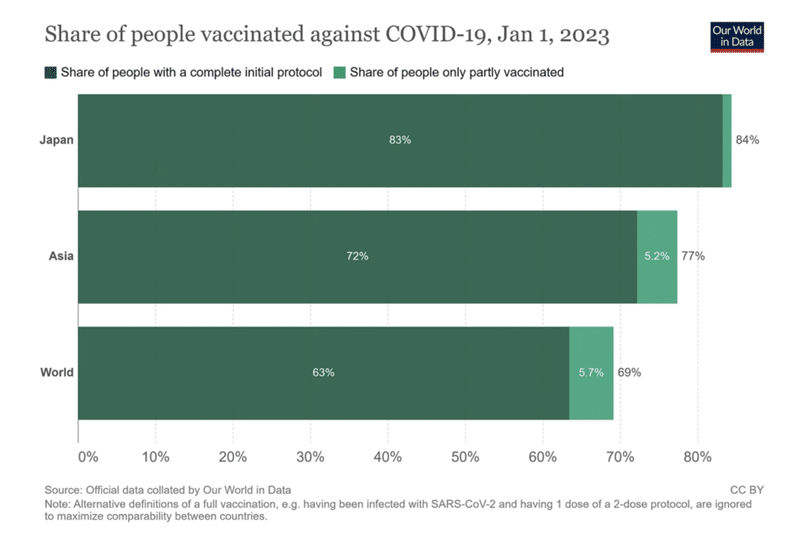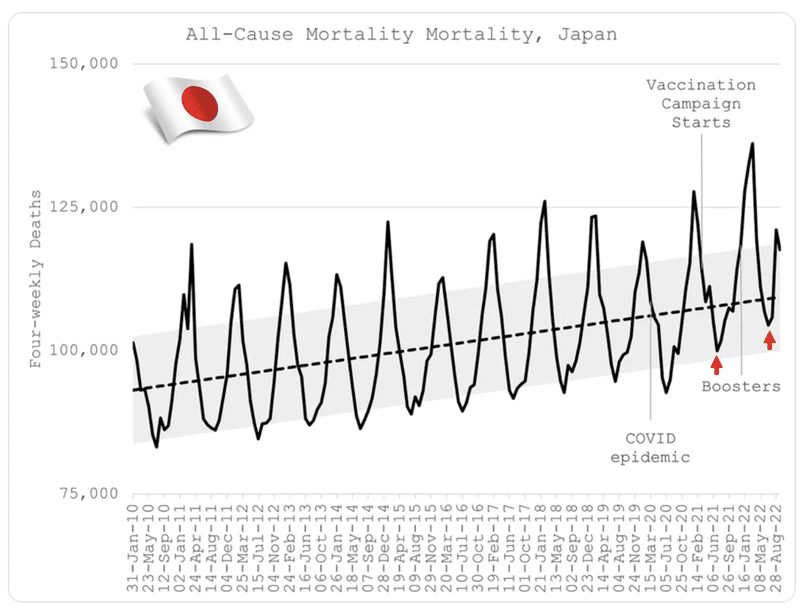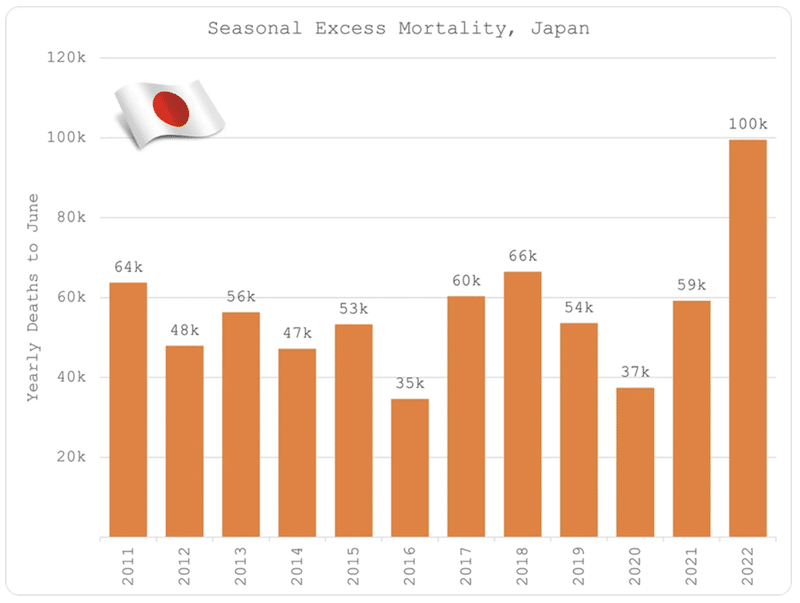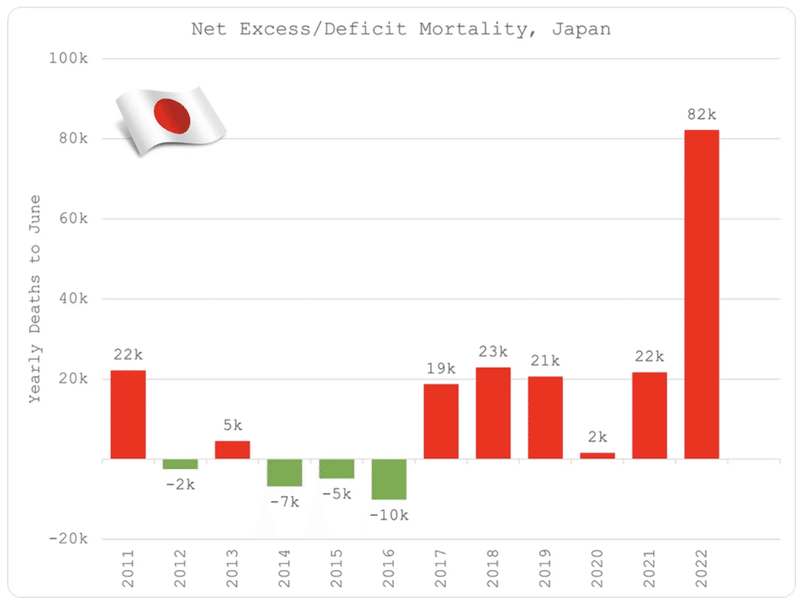ワクチン接種者のパンデミック:ファイザー社の「ブースター」注射で日本の超過死亡者数は4倍に
2023年1月3日、ローダ・ウィルソン著
「パンデミック」中の2020年、日本の全死亡者数は過去9年間すべてより少なかった。
2021年12月1日、日本はファイザー・ビオンテックの3回目の投与、つまり「ブースター注射」を開始しました。2022年末には、日本の人口の83%が "完全接種"された。
2022年中、日本は過去11年間で最も多くの超過死亡を経験した。 超過死亡者数は、2017年、2018年、2019年、2021年の約4倍でした。
ジョエル・スマリーは、2011年から2022年までの日本における季節的な赤字と過剰な死亡率を強調しました。 "論理的な分析とオッカムのカミソリは、mRNAの実験が生命の重大な損失と関連していることを示しています"と書いています。
2010年から2022年までの日本の死亡率 - 大量服従の結果
ジョエル・スマリー著
日本は、世界の他の国々やアジアの他の国々と比べても、平均をはるかに上回るコビッドの「ワクチン接種」率を達成しているコンプライアンス国家である。

しかし、死への影響が全くない病気から自分たちを「守る」ために、これほど熱心にコンプライアンスに取り組むのは奇妙なことである。

実際、図2を見ればよくわかるように、2020年のコビッド「流行」直後の日本は、死亡率の超過が全くなかったのに、死亡率では過去10年で最も大きな季節的な赤字の時期があった。
それなのに、大量mRNA実験(守る必要のないウイルス・病気から守るため)の余波で、それ以来、季節的過剰が高くなり、季節的赤字が低くなっているのです。

コビッドが流行した2020年、日本は過去10年間で最も低い「超過剰」1死亡率を記録している(図3)。何かの流行か?
mRNA実験が始まった2021年、「超過剰」死亡率は通常の範囲に戻る。
2022年には通常の2~3倍になっている...。

「季節的過剰」2(図4)を見ても、同じようなことが言える。

おそらく(公職に就いていない限り)最も憂慮すべきは、「基準値」すなわち「季節性欠損死亡率」3(図5)の水準が劇的に上昇していることであろう。
「ワクチン接種」キャンペーン以前は、季節性欠損死亡率の平均は45,000人強だった。2022年には17k4となり、2011年以降でベースラインがトレンドの下限を上回ったのは、2021年と2022年の2年だけである5。

また、「純赤字」6(図6)を見ると、コビッド「流行」の年である2020年は近年の傾向に反して大幅に減少した後、2022年は再び平年の4倍程度と大幅に増加したことが分かる。
つまり、季節的な超過確率と流行時の基準値の両方で、死亡率が平年を下回った1年後、日本は最近で最悪の死亡率に陥っているのである。
出典データ:厚生労働省調べ
参考資料:
● 1 「超過剰」は、コビド「流行」開始までの10年間のトレンドより1標準偏差以上上に位置する死亡者数と定義。
● 2 「季節性過剰」とは、トレンドラインより上に位置するすべての死亡を指す。日本では、死亡率は明らかに季節的なパターンを示し、常に1月下旬から2月上旬にピークを迎える(2011年3月の顕著な例外を除く)。
● 3 「季節性欠損死亡率」は、トレンドラインを下回る死亡数として定義される。基準値」は、毎年7月中旬を下限として設定されている。
● 4 統計学に詳しい方にとっては、3シグマイベント、すなわち100分の1の確率で偶然に起こることです。
● 5 レンジトレンドは±1標準偏差で設定されています。
● 6 「純赤字」は、季節性過剰と季節性不足の合計として定義されます。
画像はイメージ:岸田文雄内閣総理大臣(右)。出典、日本の首相がファイザーのボスと会談し、オミクロンの懸念の中でブースターの流通を加速させる。
原文:
Pandemic of the Vaccinated: Japan’s excess deaths are four times higher after Pfizer “booster” shots
BY RHODA WILSON ON JANUARY 3, 2023
In 2020, during the “pandemic,” Japan had fewer all-cause deaths than all the previous 9 years.
On 1 December 2021, Japan started administering the third dose, or “booster shots,” of Pfizer-BioNTech. At the end of 2022, 83% of Japan’s population was “fully vaccinated.”
During 2022, Japan experienced the highest number of excess deaths in 11 years. Excess deaths were approximately four times the number of those in the years 2017, 2018, 2019 and 2021.
Joel Smalley highlighted the seasonal deficit and excess mortality in Japan for the years 2011 to 2022. “Logical analysis and Occam’s razor indicate that the mRNA experiment is associated with significant loss of life,” he wrote.
Mortality in Japan 2010 to 2022 – the result of mass compliance
By Joel Smalley
Japan is a compliant nation of people, achieving way above average covid “vaccination” rates compared to the rest of the world and the rest of Asia too.
But it’s strange that they would be so zealously compliant to “protect” themselves from a disease that had absolutely no excess mortal impact.
In fact, as can be clearly seen in Figure 2, immediately after the covid “epidemic” in 2020, Japan had the most significant period of seasonal deficit in ten years in terms of mortality after no excess mortality whatsoever.
And yet, in the aftermath of the mass mRNA experiment (to protect them against a virus/disease that they did not need protection from), they have experienced higher seasonal excess and lower seasonal deficit ever since.
In 2020, the year of the covid epidemic, Japan had the lowest “super excess”1 mortality for ten years (Figure 3). Some epidemic, huh?
In 2021, when the mRNA experiment began, “super excess” mortality returns to the usual range.
In 2022, it is two to three times higher than usual… Go figure!
It is a similar picture when looking at “seasonal excess”2 (Figure 4).
Perhaps most alarming (unless you are in public office) is the dramatic rise in the “baseline” or level of “seasonal deficit mortality”3 (Figure 5).
Before the “vaccination” campaign, the seasonal deficit mortality averaged just over 45k. In 2022, it was just 17k4, with both 2021 and 2022 being the only two years since 2011 having baselines higher than the low end of the range trend5.
In terms of “net deficit”6 (Figure 6), once again 2022 has seen a substantial rise above normal levels, at around four times recent years, after 2020 (the year of the covid “epidemic”) had bucked the recent trend, coming in substantially lower.
So, after a year of below-normal mortality, measure both in terms of seasonal excess and baseline during the alleged epidemic, Japan is now experiencing the worst mortality outcomes in recent times.
Source data: Ministry of Health, Labour and Welfare of Japan
References:
1 “Super excess” is defined as deaths that lie more than 1 standard deviation above the 10-year trend up to the start of the covid “epidemic”.
2 “Seasonal excess” is defined as all deaths that lie above the trend line. Mortality follows a distinctly seasonal pattern in Japan, always peaking in late Jan / early Feb (with the notable exception of Mar 2011).
3 “Seasonal deficit mortality” is defined as deaths that lie below the trend line. The “baseline” is established as the low point each year, which is almost always mid-July.
4 For those that do stats, that’s a 3-sigma event, i.e., 1 in 100 chance of happening by chance.
5 The range trend is set +/- 1 standard deviation.
6 “Net deficit” is defined as the sum of seasonal excess and seasonal deficit.
Featured image: Prime Minister of Japan Fumio Kishida (right). Source, Japan PM meets with Pfizer boss to speed up booster distribution amid Omicron fears